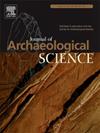评估Araucanía,智利南部玉米的烹饪意义:来自前殖民时期陶器有机残留物分析的证据
IF 2.6
1区 地球科学
Q1 ANTHROPOLOGY
引用次数: 0
摘要
玉米是南美洲种植的主要作物之一,在区域考古学中引起了极大的兴趣。然而,在被认为是主要农业生产中心外围地区,如智利南部,对玉米的研究得到的关注很少。智利南部是美洲玉米种植的最南端,考古证据可以追溯到公元1000年左右。尽管玉米明显存在,但我们对其在智利南部前殖民社会的烹饪和经济重要性的了解很少。在这项研究中,我们从188块陶器碎片中提取并分析了有机残留物,以探索玉米在从早期(ECP: 400-1000 CE)到晚期(LCP: 1000-1550 CE)陶瓷时期过渡到当地食物方式中的潜在意义。生物分子和碳稳定同位素(δ13C)分析表明,玉米不是主食。相反,我们的研究结果表明,玉米在制备重要的社会政治聚会和宴会中消费的发酵饮料方面具有潜在的突出作用。本文章由计算机程序翻译,如有差异,请以英文原文为准。
Evaluating the culinary significance of maize in the Araucanía, Southern Chile: Evidence from organic residue analysis of pre-colonial pottery
Maize, one of the primary crops cultivated in South America, has achieved significant interest in regional archaeology. However, the study of maize in regions considered peripheral to major centres of agricultural production, such as Southern Chile, has received minimal attention. Southern Chile is the southernmost point for the dispersal of maize cultivation in the Americas, with archaeological evidence dating back ca. 1000 CE. Despite the manifest presence of maize, our knowledge of its culinary and economic importance for pre-colonial societies from Southern Chile is scarce. In this study, we extracted and analysed organic residues from 188 pottery sherds to explore the potential significance of maize in local foodways over the transition from the Early (ECP: 400–1000 CE) to the Late (LCP: 1000–1550 CE) Ceramic Period. Biomolecular and carbon-stable isotope (δ13C) analyses of lipids indicate that maize was not a staple. Instead, our findings suggest that maize had a potentially prominent role in preparing fermented beverages consumed in important socio-political gatherings and feasts.
求助全文
通过发布文献求助,成功后即可免费获取论文全文。
去求助
来源期刊

Journal of Archaeological Science
地学-地球科学综合
CiteScore
6.10
自引率
7.10%
发文量
112
审稿时长
49 days
期刊介绍:
The Journal of Archaeological Science is aimed at archaeologists and scientists with particular interests in advancing the development and application of scientific techniques and methodologies to all areas of archaeology. This established monthly journal publishes focus articles, original research papers and major review articles, of wide archaeological significance. The journal provides an international forum for archaeologists and scientists from widely different scientific backgrounds who share a common interest in developing and applying scientific methods to inform major debates through improving the quality and reliability of scientific information derived from archaeological research.
 求助内容:
求助内容: 应助结果提醒方式:
应助结果提醒方式:


